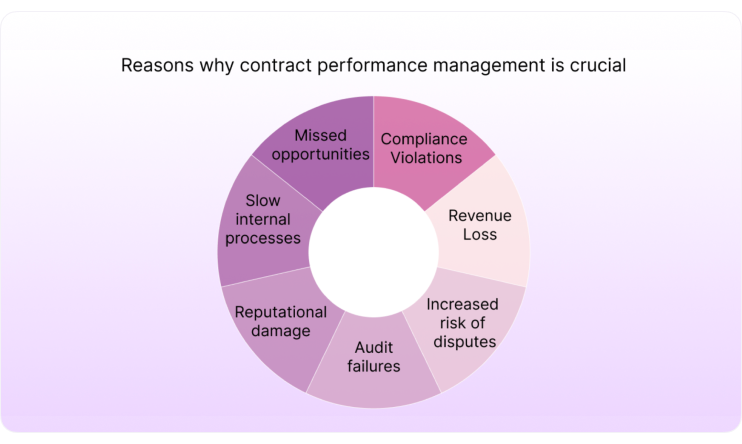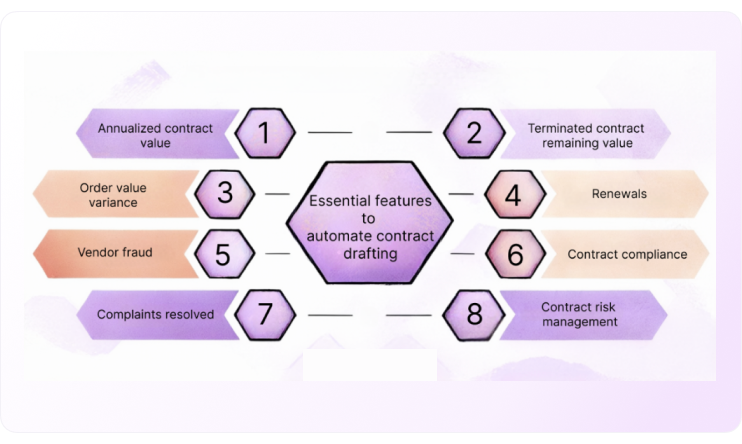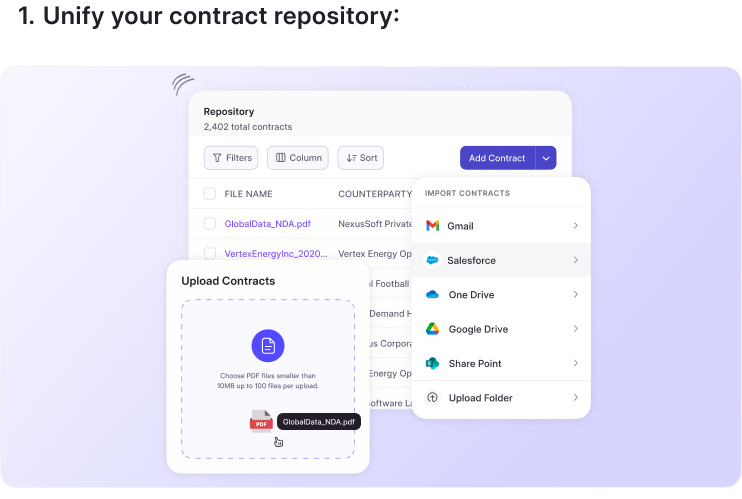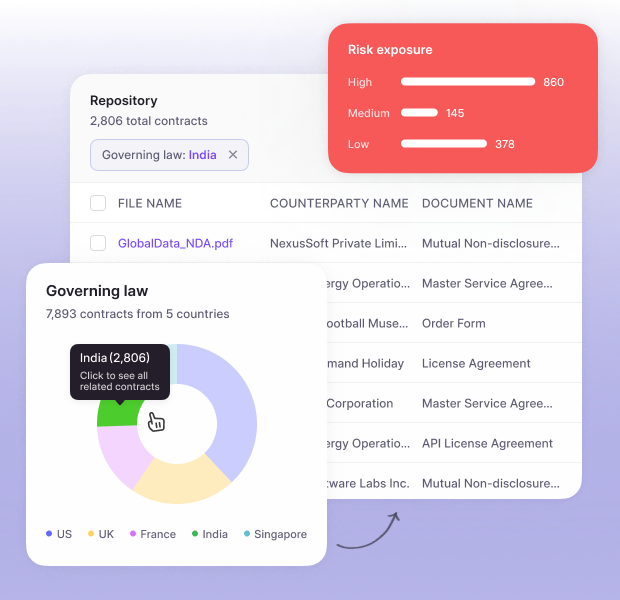Have you been asking yourself if your vendors are delivering deeper value as partners? You’re in the right place. This article explores everything you need to know about contract performance management.
What is contract performance management?
Contract performance management is a fundamental aspect of business operations that ensures that all legally binding agreements fulfill their intended purpose. Research shows that an average of 26% of contracts underperform, failing to meet their objectives. Given that at least 33% of the workforce is directly involved in contracting, effective agreement management can mitigate these issues for better contract outcomes with better allocation of business resources.
Types of contract based on performance
Complete contract performance: In this scenario, all parties fulfill their obligations under a contract and no legal action is required.
Substantial contract performance: Here, the main contractual obligations have been performed while non-material obligations are not fulfilled. This doesn’t indicate a serious breach of contract.
Contract non-performance: This scenario occurs when parties have failed to meet their primary obligations, which demand renegotiation, legal action, or termination.
Reasons why contract performance management is crucial

Most industries base a large majority of their contract data on cash flows locked in contracts. Today’s business environment requires contracts to become critical sources of cash flow information to offer mechanisms for greater adaptability and agility in supplier and client relationships. Gone are the days when contracts were mere static documents that were only legally scoured through for critical information.
Effective contract performance management through a contracting solution transforms business contracts into dynamic tools that drive business success. Recognizing, seeing, and fueling performance in contract management involves making informed renewal decisions and generating performance reports with periodic audits and check-ins. The lack of resources or ownership, inadequate training, the absence of industry standards, and a narrow view of business in downstream roles ultimately impact long-term growth and innovation.
1. Compliance violations
Without clarity on the rules of industry benchmarks, organizations are at risk of non-compliance. This can result in legal penalties, audit failures, and significant reputational damage.
2. Revenue loss
Missed opportunities for optimization and renegotiation can lead to revenue loss. Unmonitored or manually managed contracts fail to realize their full financial potential.
3. Increased risk of disputes
Inadequate oversight increases the likelihood of disputes that stem from misunderstandings and non-compliance. This further incurs costs and time.
4. Audit failures
Audit failures give rise to significant financial and operational consequences. Organizations can further face penalties and scrutiny from regulators.
5. Reputational damage
Damaged optics can erode client, partner, and stakeholder trust, affecting long-term business relationships.
6. Missed opportunities
Unforeseen overheads stem from inefficient renewal tracking and missed business opportunities. Organizations may miss out on renegotiation and strategic partnership opportunities, impacting long-term growth and innovation.
7. Slow internal processes
Increased time-to-contract and exceeding SLAs further delay project execution and reduce operational efficiency.
3 Steps to Effective Contract Performance Management
To avert the impact of these challenges, organizations should implement a structured contract performance management process:
1. Recognize performance
Periodically reviewing renewal decisions helps assess contract performance. Evaluation is done against key metrics that help decide whether to renew, renegotiate, or terminate based on strategic objectives and alignment. A comprehensive contract performance report gives insight into contract compliance, financial impact, and operational efficiency to make data-driven decisions.
2. See performance
Periodic check-ins with stakeholders for performance reviews on compliance, risk management, and opportunities for optimization help maintain visibility and control over contracts. A contract management software solution can further automate reporting and tracking to streamline processes, reduce manual errors, and offer real-time insight into contract performance.
3. Fuel performance
Training programs help legal and contracting teams stay abreast of competitive terms, industry standards, and best practices. This empowers teams for better negotiation and contract management. Benchmarking the right standards helps stay in touch with best practices, which usually reflect key changing market conditions and regulatory requirements.
Experience Flawless Contract Management Automation
Build trust and enhance team efficiency. All in one central contract performance hub.
How to Establish Great Contract Governance
“Wisely structured contracts postpone agreement on terms that would be more effectively handled after more information is available and they include contingencies commensurate with the current level of uncertainty.”
Deepak Malhotra, HBS Professor
If you’re constantly putting out fires instead of proactively preventing them, you’re long overdue to fix broken processes. These processes have expensive consequences in the long haul, leading to increased risks, compliance issues, and a lack of visibility. Good contract governance is a set of guardrails that comprise the end-to-end contracting motions from contract creation to completion to commitment.
1. Reduced cycle times
40% of contract leakage can be attributed to poor management. Manual contract management processes are sluggish and steeped in delays and bottlenecks. Well-defined and streamlined contract approval processes establish clear roles and responsibilities with standardized templates and no-code workflows which accelerate drafting, negotiation, and finalization allowing for quicker ROI.
2. Reducing contract value leakage
Contracts can often be instruments of unintended value leakage or tremendous financial opportunities. Periodic obligation and opportunity tracking, along with comprehensive contractor performance tracking, help identify deviations from agreed-upon terms and facilitate subsequent corrective actions that unlock the full value contracted for.
3. Automate and optimize the contracting lifecycle
Manual contracting is error-prone and has inconsistencies. Automation of rote work like data entry, seamless routing for approvals, and contract renewal reminders frees up precious human resources for higher-order work like negotiations and creative problem-solving.
4. Better risk management
Contracts are inherently prone to risk. Robust governance frameworks help spot threats proactively for risk mitigation and adaptive strategies minimizing impact.
5. Address operational challenges
The operational team and in-house legal team tend to bear the weight of managing high-volume contracts. Well-crafted frameworks lessen the pressure with centralized contract data and automated contract management workflows reducing both the time and effort for manual tasks so resources are redirected to vendor relationship management and performance improvement initiatives.
6. Centralize the organization’s resourcing
Since contracts straddle multiple organizational departments, a unified framework fosters collaboration and ensures that all departments are attuned to contractual objectives. A single source of truth for all contract data eliminates work duplication and data silos eliminating opacity.
7. Enhanced vendor collaboration
Robust governance frameworks nurture open communication and collaboration with vendors with clear expectations and pre-defined contract performance metrics. Transparency and trust further allow for efficient problem-solving and continual process optimization.
8. Agility and adaptability
As businesses evolve, frameworks for renegotiation and restructuring ensure that contracts foster these dynamic needs. Refining contract practices promises greater efficiency with guardrails focused on identifying opportunities for continuous improvement.
Key contract management performance metrics

While a contract lifecycle management solution does the heavy lifting in terms of management, maintaining review versions, final validation, shipping for signatures, mapping parent contracts to subsequent child contracts, and tracking important deadlines, the efficiency hinges on the strategic selection of contract management KPIs. Measuring performance needs a blend of both objective metrics and qualitative indicators through comprehensive contract performance measures. Here are some key contract performance metrics:
1. Annualized contract value
This is the total contract value divided by the number of years covered which offers a standardized measure of recurring revenue generated by a contract. This is especially useful for forecasting financial performance and resource allocation for longer-term contracts.
2. Terminated contract remaining value
This indicator factors in monthly recurring revenue and the length of the contract term to calculate the value forfeited upon contract termination. Any applicable termination fees offer a thorough estimate of the financial losses associated with agreement terminations.
3. Order value variance
This indicator estimates the difference between the original and the actual value of the contract placed during the contract period. It helps spot maverick spending, unnecessary overheads, and the underutilization of contracted services for better course correction.
4. Renewals
Contract renewal metrics include auto-renewal rates, the overall percentage of contracts renewed, and the value of contracts renewed versus non-renewed. They reflect customer satisfaction and the effectiveness of contracted services which help identify trends and areas for improvement in negotiations and customer relationship management.
5. Vendor fraud
This indicator monitors fraudulent activity by vendor partners such as inflated invoices, unauthorized substitutions, or non-performance after payments. Organizations can thereby eliminate financial losses from unscrupulous business practices.
6. Contract compliance
Compliance is essential to seamless business operations and conducive supplier relationships. This indicator measures service levels, payment terms, and other contractual obligations set against compliance benchmarks in respective industries.
7. Complaints resolved
Businesses spend $870 billion on dispute resolution every year. Despite best intentions, conflicts over contract clauses tend to happen. Prompt compliant resolution rates usually indicate good communication and smooth feedback mechanisms. This indicator helps identify recurring contract performance issues to address potential liabilities.
8. Contract risk management
This contract risk management metric is measured across different stages of the contract lifecycle like the number of risks identified during legal review, mitigation strategies implemented during negotiations, or ongoing risk assessment. These proactive actions help mitigate the impact of potential disruptions in service delivery.
The above contract management performance metrics offer insights into financial planning and resource allocation from accurate revenue forecasting for better customer retention initiatives. Besides these metrics, other qualitative performance criteria include payment schedules, collaboration performance, quality, and renewal potential.
How to improve contract performance
HyperStart is an unrivaled contract management software that helps you stay ahead of the game by optimizing contract lifecycle management performance. Designed to streamline the contracting lifecycle end-to-end, we help you turn contracts from static documents to dynamic digital assets.
Here are the top ways to make contract performance management easier:
1. Unify your contract repository

Nearly half (49%) of organizations admit they’re in the dark when it comes to a defined process for storing contracts after execution. It’s impossible to fulfill your obligations if you don’t know where your contract or contract data are stored. A centralized repository as a cornerstone of good contract performance eliminates the risk of misplaced documents and ensures quick and secure contract retrieval. This directly ties into contract data visibility on key payment and liability clauses. HyperStart’s OCR technology also searches through contracts in seconds so you find the information you need quickly.
2. Automate contract creation
Manual contract authoring and assembly is time-consuming, prone to mistakes, and wasteful. With HyperStart, you can standardize templates with pre-approved clauses and templates that accelerate the drafting process and ensure consistency and compliance. No-code workflows streamline the routing of contracts and eliminate manual routing and follow-ups, ensuring faster deal closures.
3. Auto-capture contract data
HyperStart’s automated metadata extraction is 99% accurate. This helps you quickly review key contract information like contract data, contract owner, contract value, contract duration, obligation due dates, liability clauses, logo usage, and contract renewal dates. Manual extraction involves using spreadsheets, which are unreliable and laborious. Automated contract management tools extract this data automatically into a dashboard with smart fields and tags.
4. Set up timely reminders
Automated reminders can notify relevant personnel of upcoming deadlines for both signatures and renewals, preventing execution delays, missed deadlines, and potential contract breaches.
5. Integrate with existing systems

Another way to manage the performance of your contracts is to sync them to your existing systems without duplicating work across departments and stakeholders. HyperStart’s frictionless integrations with popular CRM, ERP, and finance software sync the data stored in contracts for enhanced collaboration, wider visibility, control, and decision-making.
6. Standardize legal compliance
HyperStart deploys best practices for standardizing pre-approved contract templates while regularly updating contract clauses to reflect governing laws. As a critical aspect of contract performance management, these standard templates and clauses reduce contracting overheads, the risk of non-compliance, and legal disputes.
7. Real-time contract review
Research has it that the initial contract review can take an average of 92 minutes while an AI engine can do that in 26 seconds. AI-redlining helps quickly identify and address any deviations from agreed-upon terms. A browser-native Microsoft Word plugin enables you to review contracts in real time with up-to-date contract information.
8. Visualize data with reports & dashboards

Automated reports and dashboards equip leaders to have insightful conversations about contracting relationships from what is the simplest view of them to what is the richest. Deep insights into contract status, review times, number of turns, contract milestones, contract performance, liabilities, and risks. Visualizing contract data enables organizations to refine contract terms, track contract performance, and implement strategic initiatives saving budget and time.
Experience Flawless Contract Management Automation
Build trust and enhance team efficiency. All in one central contract performance hub.
Concluding thoughts
Contracting is most effective when the deliveries are timely, of high service quality, under budget, with minimal change orders, and complaint-free. Flying blind can risk strategic vendor partners becoming complacent, slow, and intractable. At its core, contract performance management seeks to establish whether obligations are met cordially, on time, and if the relationship has a future and to expand the limits of your mutual attitude towards risk and opportunity.
The top performers in contract management are laser-focused on accelerating business. Among the metrics to keep track of are deal closure times, speed of change management, and quick issue resolution. Research has it that the best contract management performers are:
5 times more likely to analyze the frequency and source of claims and disputes
4 times more likely to monitor the frequency and nature of contract changes as well as the cycle times to manage changes and disputes
2 times more likely to monitor cycle times for key process phases and the frequency with which specific terms are negotiated
Simply put, contract performance management ensures that you have the arsenal you need to simplify, adapt, and systematize the contracting lifecycle to move the business forward faster.









![Who is a Contract Manager? [Roles + Skills + Responsibilities]](https://www.hyperstart.com/wp-content/uploads/2025/02/Blog-33-white-scaled.webp)

